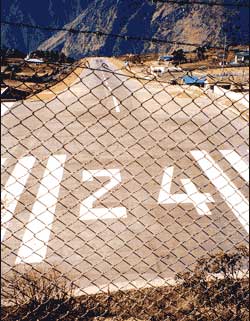 Something does not make much sense here. Political instability, the royal massacre, 11 September, India-Pakistan tension, and the Maoist insurgency hurt Nepal's tourism very badly last year. So how come the number of trekkers visiting the Khumbu was not affected much in 2001 compared to the previous year?
Something does not make much sense here. Political instability, the royal massacre, 11 September, India-Pakistan tension, and the Maoist insurgency hurt Nepal's tourism very badly last year. So how come the number of trekkers visiting the Khumbu was not affected much in 2001 compared to the previous year? The only explanation is: Mt Everest. It is still Nepal's main draw. And adventure tourists appear less spooked by security concerns than other types of tourists. Just over 25,000 trekkers and mountaineers came to Namche Bazar in 2000, while last year the numbers dropped slightly to 22,000. Khumbu is a one-industry area, and everyone here is looking forward to the spring season. A dip is expected, but the 2001 figures give them hope that things will not be so bad.
"They're still coming to see Mt Everest," says Jangbu Sherpa of Namche's Caf? Danfe which is called "the world's highest bar". Despite a quiet new year owing to a dawn to dusk curfew in Namche and the state of emergency, tourists are still walking up the trail from Lukla. They gather for an early drink and a round of pool at the Caf? Danfe and head off to their lodges before the soldiers from the barracks overlooking Namche's ampitheatre begin their patrols.
There is talk of a trekker who forgot there was a curfew and ventured out at dawn to catch the sun rise over Mt Everest when an alert sentry at the barracks accosted them with a semi-automatic. But, by and large, the counter-insurgency war seems to be happening far away from the stupendously beautiful scenery of these mountains.
The Maoist attack on the barracks at Salleri on 26 November that plunged the country into an emergency, and brought the army out to fight the Maoists, is the nearest that the fighting has come. But trekking agents are worried that exaggerated international news reports that cited the attacks as happening "at the foothills of Mt Everest" may have done some damage to Khumbu tourism.
Lukla is a two day walk from Salleri and there are hopes here of a tourism revival following the renovation of Lukla airport at a cost of Rs 130 million. Lukla's famous inclined runway is now a modern asphalt strip. No more parking problems for aircraft, and the hair-raising landings are smoother.
But the emergency has put a dampener on things. Then there was a scare in mid-January when plastic explosives, copper wire, and Maoist propaganda literature were found in a village below the airstrip after an explosion. There is no army presence in Lukla and there is just a small police contingent for the passenger security checks.
Lukla airport's station-in-charge, Passang Geljen Sherpa has asked for additional security from the Civil Aviation Authority in Kathmandu. "We haven't had a response so far," he said. When asked why, a CAA official in Kathmandu told us the army was overstretched guarding five other airports and it was unlikely that soldiers could be spared for Lukla.
Anticipating the inaction, Lukla citizens have got together on their own to maintain security and protect the tourism industry. They close shop early and patrols keep a check on new faces in town. "It's the best we can do," says Lukla VDC chairman, Funuru Sherpa. "There is no help from Kathmandu and after the attack on Salleri, the two dozen policemen who were here were withdrawn to the army barracks in Namche." The policemen are now back, but they haven't been able to instill much confidence in Lukla.
There are up to four flights that come in every day, ferrying mainly Japanese trekkers. By the time the sun sets behind the Karyolung ridgeline, Lukla is quiet, the restaurants and hotels close early, policemen melt into their separate quarters in the town. By next morning there is a brief flurry of activity as Twin Otters fly in from Kathmandu, the tourists hire their porters, and are off on the Namche trail.
But there is something other than the Maoist threat that makes Lukla residents nervous. It is the CAA's reported plan to refurbish Syangboche airstrip above Namche and make it capable of taking short-takeoff-and-landing aircraft. "If that happens, we're ruined," says a Lukla hotel owner about the business that will bypass Lukla as trekkers and mountaineers start flying directly to Namche.
The decision to build Syangboche appears to be the result of a falling out between tourism minister Bal Bahadur KC and his party cadre in Lukla who staged a demonstration against him on 16 October during the inauguration ceremony of the renovated airport.
"Bal Bahadur was angry about the loss of face in front of all those dignitaries," explained a Lukla lodge-owner. "His revenge was to make tourists go directly to Syangboche." KC's cadre were unhappy about the shoddy construction of the newly-built supporting wall along the northern edge of the runway which already looks fragile and may not survive the next monsoon.
If Syangboche goes ahead, Lukla locals may repeat their 1997 sit-ins on the runway to protest cargo and passenger helicopters flying tourists directly to Syangboche. The airport opened for traffic only after the government stopped those helicopter flights.
But even if Syangboche does open, it may be safer for trekkers to keep flying to Lukla to allow time to acclimatise. An engineer who flew to Syangboche to survey the runway extension recently had to be evacuated after he was felled by altitude sickness.


